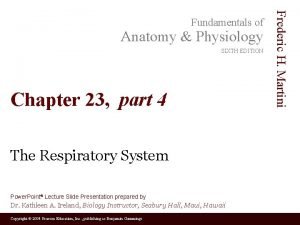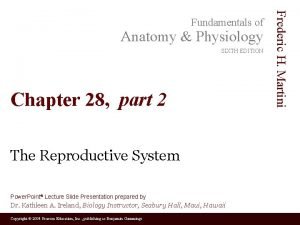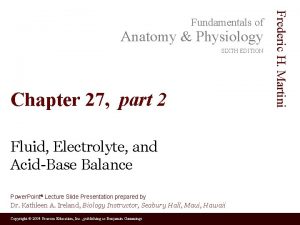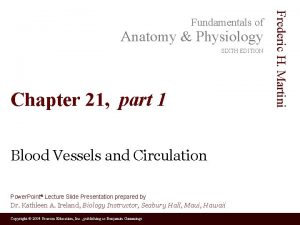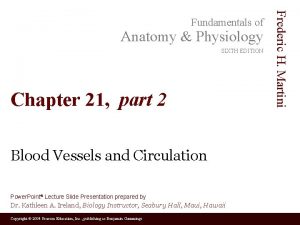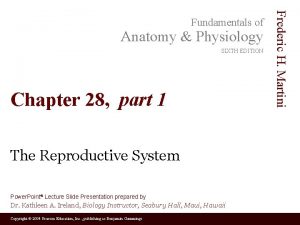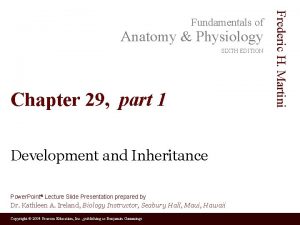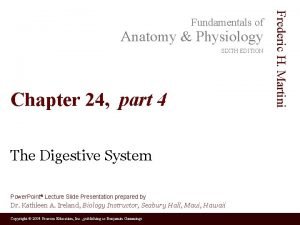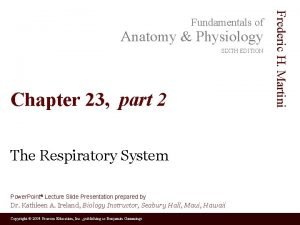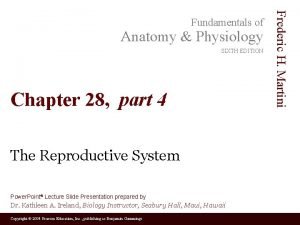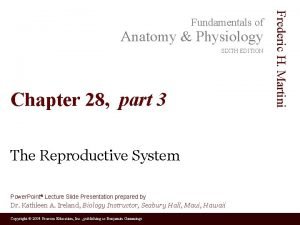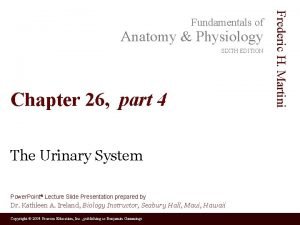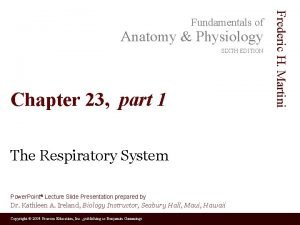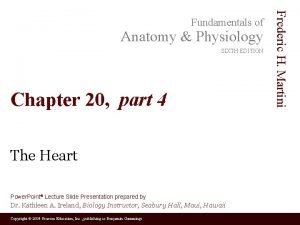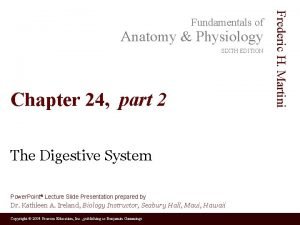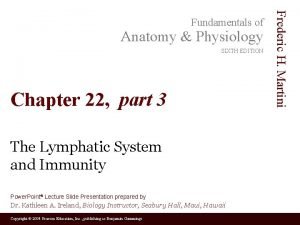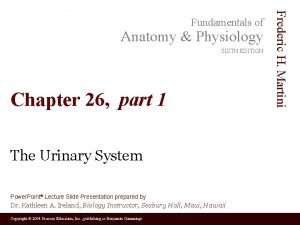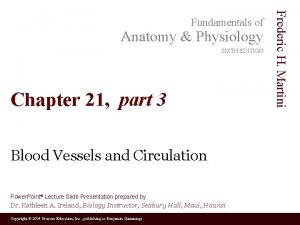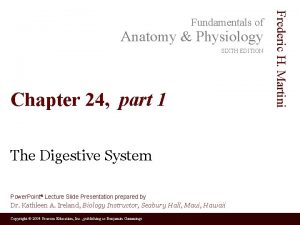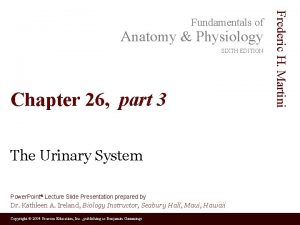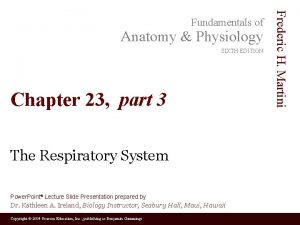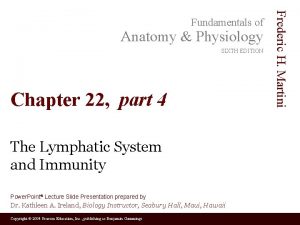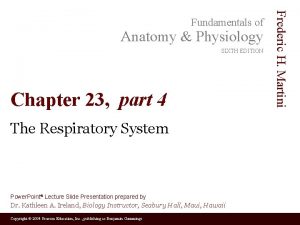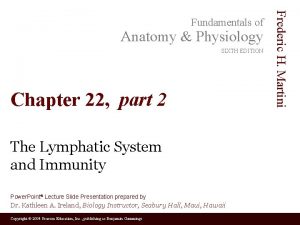Anatomy Physiology SIXTH EDITION Chapter 27 part 1



























- Slides: 27

Anatomy & Physiology SIXTH EDITION Chapter 27, part 1 Fluid, Electrolyte, and Acid-Base Balance Power. Point® Lecture Slide Presentation prepared by Dr. Kathleen A. Ireland, Biology Instructor, Seabury Hall, Maui, Hawaii Copyright © 2004 Pearson Education, Inc. , publishing as Benjamin Cummings Frederic H. Martini Fundamentals of

Learning Objectives • Explain what is meant by “fluid balance, ” “electrolyte balance, ” and “acid-base balance” • Compare the compositions of intracellular and extracellular fluids • Identify the hormones that play important roles in regulating fluid and electrolyte balance • Describe the movement of fluid that takes place within the ECF, between the ECF and the ICF, and between the ECF and the environment Copyright © 2004 Pearson Education, Inc. , publishing as Benjamin Cummings

Learning Objectives • Discuss how sodium, potassium, calcium and chloride ions are regulated to maintain electrolyte balance • Explain the buffering systems that balance the p. H of the intracellular and extracellular fluids • Describe the compensatory mechanisms involved in acid-base balance Copyright © 2004 Pearson Education, Inc. , publishing as Benjamin Cummings

SECTION 27 -1 Fluid, Electrolyte and Acid-base Balance: An Overview Copyright © 2004 Pearson Education, Inc. , publishing as Benjamin Cummings

Maintenance of normal fluid volume and composition is vital • Extracellular fluid (ECF) • Interstitial fluid, plasma, and other body fluids • Intracellular fluid (ICF) • The cytosol Copyright © 2004 Pearson Education, Inc. , publishing as Benjamin Cummings

Fluid and electrolyte balance • Fluid balance • The amount of water gained each day equals the amount lost • Electrolyte balance • The ion gain each day equals the ion loss • Acid-base balance • H+ gain is offset by their loss Copyright © 2004 Pearson Education, Inc. , publishing as Benjamin Cummings

SECTION 27 -2 An Introduction to Fluid and Electrolyte Balance Copyright © 2004 Pearson Education, Inc. , publishing as Benjamin Cummings

The ECF and the ICF are two distinct fluid compartment • ICF • The cytosol of cells • Makes up about two-thirds of the total body water • ECF • Major components include the interstitial fluid and plasma • Minor components include all other extracellular fluids Copyright © 2004 Pearson Education, Inc. , publishing as Benjamin Cummings

Figure 27. 1 The Composition of the Human Body Copyright © 2004 Pearson Education, Inc. , publishing as Benjamin Cummings Figure 27. 1 a

Regulation of fluids and electrolytes • Homeostatic mechanisms respond to changes in ECF • No receptors directly monitor fluid or electrolyte balance • Respond to changes in plasma volume or osmotic concentrations • All water moves passively in response to osmotic gradients • Body content of water or electrolytes rises if intake exceeds outflow Copyright © 2004 Pearson Education, Inc. , publishing as Benjamin Cummings

Figure 27. 2 Cations and Anions in Body Fluids Copyright © 2004 Pearson Education, Inc. , publishing as Benjamin Cummings Figure 27. 2

Primary regulatory hormones • Antidiuretic hormone (ADH) • Stimulates water conservation and the thirst center • Aldosterone • Controls Na+ absorption and K+ loss along the DCT • Natriuretic peptides (ANP and BNP) • Reduce thirst and block the release of ADH and aldosterone Copyright © 2004 Pearson Education, Inc. , publishing as Benjamin Cummings

Interplay between fluid balance and electrolyte balance • Different mechanisms regulate fluid and electrolyte balance • This distinction is vital in the clinical setting Copyright © 2004 Pearson Education, Inc. , publishing as Benjamin Cummings

SECTION 27 -3 Fluid Balance Copyright © 2004 Pearson Education, Inc. , publishing as Benjamin Cummings

Fluid movement within the ECF • Fluid moves freely within ECF compartment • Water losses are normally balanced by gains • Eating • Drinking • Metabolic generation Copyright © 2004 Pearson Education, Inc. , publishing as Benjamin Cummings

Figure 27. 3 Fluid Exchanges Copyright © 2004 Pearson Education, Inc. , publishing as Benjamin Cummings Figure 27. 3

Fluid exchange with the environment • The major routes of fluid exchange with the environment include: • Water loss • Temperature rise from fever • Water gains Copyright © 2004 Pearson Education, Inc. , publishing as Benjamin Cummings

Water excess and depletion • Hyponatremia • Na+ concentration in the ECF is reduced (overhydration) • Hypernatremia • Na+ in the ECF is abnormally high • Dehydration • Develops when water loss outpaces water gains Copyright © 2004 Pearson Education, Inc. , publishing as Benjamin Cummings

Fluid shifts • Water movement between ECF and ICF • If ECF becomes hypertonic relative to ICF, water moves from ICF to ECF • If ECF becomes hypotonic relative to ICF, mater moves from ECF into cells PLAY Animation: Introduction to Body Fluids Copyright © 2004 Pearson Education, Inc. , publishing as Benjamin Cummings

SECTION 27 -4 Electrolyte Balance Copyright © 2004 Pearson Education, Inc. , publishing as Benjamin Cummings

Problems with Electrolyte Balance • Usually result from sodium ion imbalances • Potassium imbalances are less common, but more dangerous Copyright © 2004 Pearson Education, Inc. , publishing as Benjamin Cummings

Sodium balance • Rate of sodium uptake across digestive tract directly proportional to dietary intake • Sodium losses occur through urine and perspiration • Shifts in sodium balance result in expansion or contraction of ECF • Large variations corrected by homeostatic mechanisms • Too low, ADH / aldosterone secreted • Too high, ANP secreted Copyright © 2004 Pearson Education, Inc. , publishing as Benjamin Cummings

Figure 27. 4 The Homeostatic Regulation of Normal Sodium Ion Concentrations in Body Fluids Copyright © 2004 Pearson Education, Inc. , publishing as Benjamin Cummings Figure 27. 4

Figure 27. 5 The Integration of Fluid Volume Regulation and Sodium Ion Concentrations in Body Fluids Copyright © 2004 Pearson Education, Inc. , publishing as Benjamin Cummings Figure 27. 5

Potassium balance • Potassium ion concentrations in ECF are low • Not as closely regulated as sodium • Potassium ion excretion increases as • ECF concentrations rise • Aldosterone secreted • p. H rises • Potassium retention occurs when p. H falls Copyright © 2004 Pearson Education, Inc. , publishing as Benjamin Cummings

ECF Concentrations of other electrolytes • Calcium balance • Bone reserves, absorption in the digestive tract, and loss at kidneys • Magnesium balance • Absorbed by the PCT to keep pace with urinary losses Copyright © 2004 Pearson Education, Inc. , publishing as Benjamin Cummings

ECF Concentrations of other electrolytes • Phosphate balance • Absorbed by the PCT in response to calcitriol • Chloride balance • Absorbed at digestive tract to balance losses in urine and sweat PLAY Animation: Electrolyte homeostasis Copyright © 2004 Pearson Education, Inc. , publishing as Benjamin Cummings
 Human anatomy and physiology seventh edition marieb
Human anatomy and physiology seventh edition marieb Human anatomy & physiology edition 9
Human anatomy & physiology edition 9 Human anatomy and physiology 10th edition
Human anatomy and physiology 10th edition Peter piper tongue twister
Peter piper tongue twister The sixth sick sheik's sixth sheep's sick lyrics
The sixth sick sheik's sixth sheep's sick lyrics Chapter 14 anatomy and physiology
Chapter 14 anatomy and physiology Waistline
Waistline Anatomy and physiology chapter 8 special senses
Anatomy and physiology chapter 8 special senses Chapter 13 anatomy and physiology of pregnancy
Chapter 13 anatomy and physiology of pregnancy Chapter 2 basic chemistry anatomy and physiology
Chapter 2 basic chemistry anatomy and physiology Heat and cold
Heat and cold Chapter 14 the digestive system and body metabolism
Chapter 14 the digestive system and body metabolism Chapter 10 blood anatomy and physiology
Chapter 10 blood anatomy and physiology Anatomy and physiology chapter 15
Anatomy and physiology chapter 15 Anatomy and physiology chapter 1
Anatomy and physiology chapter 1 Holes anatomy and physiology chapter 1
Holes anatomy and physiology chapter 1 Gi tract histology
Gi tract histology Medial and lateral
Medial and lateral Chapter 2 human reproductive anatomy and physiology
Chapter 2 human reproductive anatomy and physiology Anterior surface of scapula
Anterior surface of scapula Chapter 6 general anatomy and physiology
Chapter 6 general anatomy and physiology Olecranal region
Olecranal region Biochemistry sixth edition 2007 w.h. freeman and company
Biochemistry sixth edition 2007 w.h. freeman and company Computer architecture a quantitative approach sixth edition
Computer architecture a quantitative approach sixth edition Automotive technology sixth edition
Automotive technology sixth edition Automotive technology sixth edition
Automotive technology sixth edition Citation sample pdf
Citation sample pdf Computer architecture a quantitative approach sixth edition
Computer architecture a quantitative approach sixth edition




























